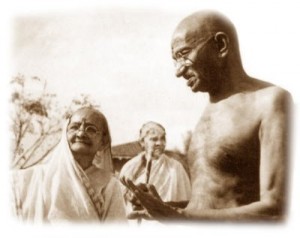January 29:
 “Every moment of our life should be filled with mental or physical activity but that activity should be sattvika, tending to truth.”
“Every moment of our life should be filled with mental or physical activity but that activity should be sattvika, tending to truth.”
–Gandhi (From Yervada Mandir, pp. 23-26)
Energy drives the human being and all of life, but not all energy is the same. The Bhagavad Gita breaks it down into three gunas or states: tamas, or inertia and passivity; rajas, or restless action; and sattva, or harmony and balance. Gandhi’s vision of the nonviolent method of satyagraha, or truth-force, was a state of sattvic action–full of compassion, courage and self-sacrifice for the sake of upholding the unity–not the separation– of life.
How do we recognize sattva? Imagine walking into a quiet room with a little light coming in through the window and a few people are seated together, smiling at a newborn baby. There is power in the stillness, and there is a healing life in the baby. In that presence, a sense of the sacred pervades. You do not want to do anything to break the peace of that moment. Or again, imagine if, as in the beautiful image from the Bhagavad Gita, our minds were like a flame in a windless place: powerful but unperturbed. And imagine if our lives could have that power forever. The promise, Gandhi suggests, is that we can regain that state. It is so very natural to us.
Experiment in Nonviolence:
The next time you are agitated about some injustice, stop, collect yourself, and get to work resolving the problem in some little way. Observe inside how your energy moves naturally from rajas to sattva.
Daily Metta 2015, a service of the Metta Center for Nonviolence, is a daily reflection on the strategic and spiritual insights of Mahatma Gandhi in thought, word and deed. As Gandhi called his life an “experiment in truth,” we have included an experiment in nonviolence to accompany each Daily Metta. Check in every day for new inspiration. Each year will be dedicated to another wisdom teacher.








